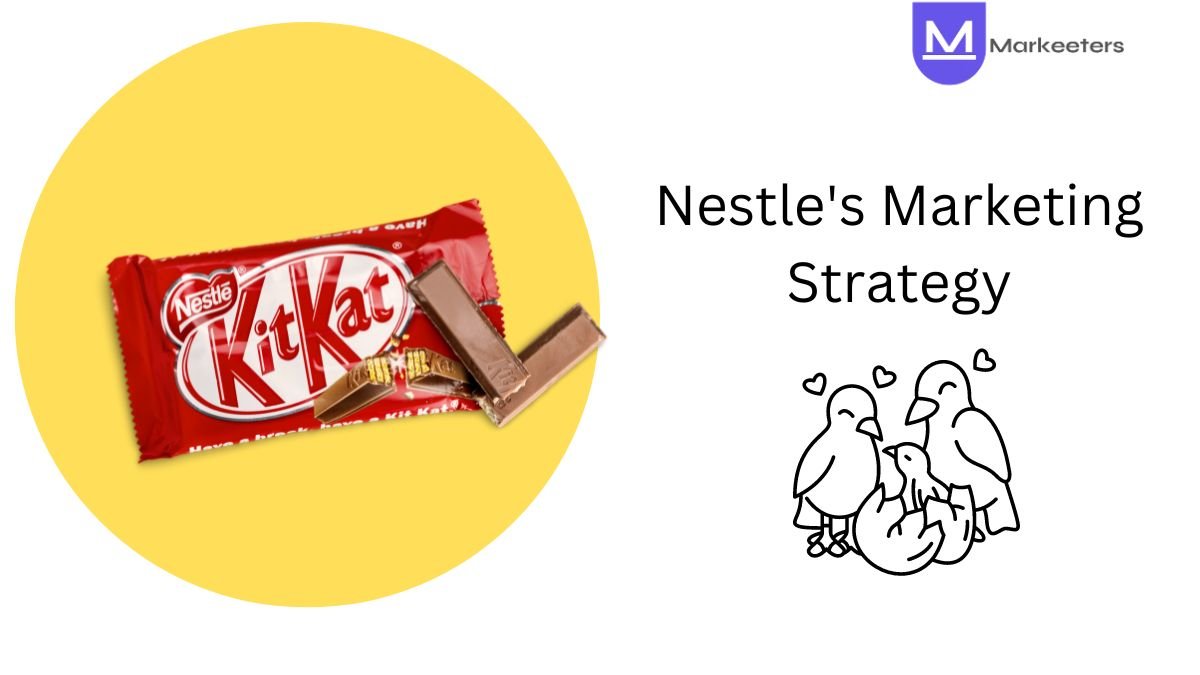Ah, Nestle. From convincing kids that chocolate milk comes from brown cows to making adults believe they need ‘premium’ water, Nestlé’s marketing wizards have been spinning tales sweeter than their candy bars for over a century.
Buckle up as we unwrap the deliciously clever strategies that have made this Swiss giant a household name. Warning: Reading this may cause sudden cravings for KitKats and a strange urge to question the origins of your dairy products.
So, let’s dive into the deliciously complex world of Nestle’s marketing strategy, shall we?
Target Audience
One of the most impressive aspects of Nestle’s marketing strategy is its ability to target just about everyone with a pulse (and some without – hello, pet food market!). But let’s break it down a bit:
1. The Tiny Humans: Nestle starts early, targeting new parents with its infant nutrition products. Because nothing says “responsible parenting” like powdered milk from a multinational corporation, right?
2. The Sugar-Fueled Youth: As kids grow, so does Nestle’s product range. From chocolate bars to breakfast cereals, they’ve got the “make mom say no in the supermarket aisle” demographic on lock.
3. The Caffeine-Dependent Adults: With brands like Nespresso and Nescafé, Nestle ensures that the world’s workforce remains jittery and productive.
4. The Health-Conscious Consumers: For those who’ve realized that maybe subsisting on chocolate isn’t a viable long-term strategy, Nestle offers “healthier” options like and Nesfit.
By casting such a wide net, Nestle ensures that no potential customer slips through the cracks.
The 4 Ps of Nestle’s Sweet Symphony
Now, let’s examine how Nestle orchestrates its marketing mix, aka the 4 Ps:
1. Product

From KitKat to Nestle Icetea, Nestle’s product range is more diverse than a United Nations assembly. They’ve got something for every palate, dietary restriction, and questionable life choices.
2. Price
Nestle plays the pricing game like a virtuoso. They offer everything from budget-friendly options (looking at you, Maggi noodles) to luxury indulgences (hello, Nespresso, you fancy caffeine delivery system).
3. Place
You’d be hard-pressed to find a corner of the globe where Nestle hasn’t left its chocolatey fingerprints. Supermarkets, convenience stores, vending machines – if there’s a place to sell food, Nestle is there, like a tasty, omnipresent deity.
4. Promotion
Ah, the pièce de résistance of Nestle’s marketing strategy. From star-studded Nespresso ads to earworm jingles about breaking off pieces of KitKat bars, Nestle’s promotional game is stronger than the coffee they sell.
Marketing Strategies: The Secret Sauce
Nestle didn’t become a global powerhouse by accident. Their marketing strategies are as carefully crafted as their Swiss chocolate. Let’s unwrap some of their key approaches:
1. Brand Diversification
Nestle owns more brands than you’ve had hot dinners. This allows them to appeal to different market segments without diluting their core brand identity. It’s like having multiple personalities, but profitable!
2. Emotional Marketing
Nestle knows that the way to a consumer’s wallet is through their heart (or stomach). Their ads often play on emotions, from the warm fuzzies of sharing a KitKat to the sophistication of sipping Nespresso. It’s manipulative, but hey, that’s marketing for you.
3. Localization
Despite being a global brand, Nestle adapts its products and marketing to local tastes faster than you can say “cultural sensitivity.” Wasabi KitKat in Japan? Sure! Maggi noodles tailored to Indian palates? You bet!
4. Digital Domination
Nestle has embraced the digital age with the enthusiasm of a kid in a candy store (which, coincidentally, they probably own). From social media campaigns to influencer partnerships, they’re all over the internet like chocolate on a s’more.
5. Sustainability
In recent years, Nestle has been working hard to polish its image by emphasizing sustainability. Whether it’s sourcing ethical cocoa or reducing plastic waste, they’re trying to show that they care about more than just profit.
6. Strategic Partnerships
Nestle isn’t afraid to play nice with others when it suits them. From co-branding efforts to strategic alliances, they know that sometimes, two brands are better than one. It’s like a corporate version of “The Bachelor,” but with less drama and more synergy.
7. Constant Innovation
Nestle pumps out new products faster than a chocolate fountain at a wedding. By constantly innovating, they keep consumers interested and competitors on their toes. It’s a “throw spaghetti at the wall and see what sticks” approach, but with more market research and less pasta.
Nestle’s Best: KitKat
Let’s take a closer look at one of Nestle’s most successful brand strategies: the humble KitKat. This chocolate-covered wafer has become a global phenomenon, thanks to some clever marketing moves:
The Slogan
“Have a break, have a KitKat” is pure genius. It positions the product as not just a snack, but a moment of respite in our busy lives. It’s not emotional manipulation if it involves chocolate, right?
Customization
KitKat has released more flavors than there are stars in the sky (slight exaggeration, but you get the point). From the classic milk chocolate to oddities like sake and baked potato, there’s a KitKat for every palate and Instagram feed.
Social Media Savvy
KitKat’s social media game is stronger than the caffeine content in their chocolate. They’ve mastered the art of witty replies and timely posts, turning their brand into a social media darling.
Cultural Integration
In Japan, KitKat has become synonymous with good luck, thanks to its phonetic similarity to “kitto katsu” (surely win). Nestle capitalized on this, creating special editions for exam seasons. It’s cultural appropriation, but make it chocolate!
The Dark Side of the Chocolate Bar
Of course, it wouldn’t be a comprehensive look at Nestle’s marketing strategy without acknowledging some of the challenges and controversies they’ve faced:
1. Water Woes: Nestle’s water bottling practices have come under fire in recent years, with critics accusing the company of depleting natural resources for profit. It turns out that trying to bottle and sell a basic human right doesn’t always go over well. Who knew?
2. Labor Issues: The company has faced accusations of using child labor in its cocoa supply chain. Nothing sours the taste of chocolate quite like the thought of exploitation.
3. Greenwashing Allegations: While Nestle talks a big game about sustainability, some argue that their efforts are more about marketing than genuine change. It’s a classic case of “Do as I say, not as I do.”
These issues have forced Nestle to adapt its marketing strategy, focusing more on corporate social responsibility and transparency. But it’s clear that Nestle understands the importance of public perception in the court of consumer opinion.
The Future of Nestle’s Marketing Strategy
So, what’s next for Nestle? Here are some predictions:
1. Increased Focus on Health and Wellness
As consumers become more health-conscious, expect Nestle to double down on its “healthier” options. Soon, you might be seeing ads for KitKat-branded kale chips. (Please, Nestle, don’t actually do this.)
2. Sustainability Push
Nestle will likely continue to emphasize its sustainability efforts, possibly even venturing into the plant-based protein market. Chocolate-covered cricket bars, anyone?
3. Personalization
With the rise of big data, Nestle could use consumer information to offer more personalized products and marketing. Imagine a world where your Nespresso machine knows your caffeine preferences better than you do. Scary? Maybe. Convenient? Definitely.
4. Virtual and Augmented Reality
Don’t be surprised if Nestle starts experimenting with VR and AR in its marketing. Virtual chocolate tastings could become the new wine tastings.
5. Continued Global Expansion
There’s always another market to conquer. Nestle’s marketing strategy will likely focus on further penetration into emerging markets, adapting its products and messaging to new cultural contexts.
Conclusion
Love them or loathe them, there’s no denying that Nestle’s marketing strategy is as multi-layered as their Crunch bars. From their wide-reaching target audience to their adaptable marketing mix, Nestle has crafted a marketing approach that’s as versatile as it is effective.
Sure, they’ve had their fair share of missteps and controversies, but like a skilled chocolatier, Nestle has shown an ability to remold its image and adapt to changing consumer tastes and values. Their marketing strategy is a masterclass in brand management, product diversification, and global reach.
So the next time you find yourself absent-mindedly reaching for a Nestle product, take a moment to appreciate the complex web of marketing strategies that led you to that decision. And then enjoy your snack. After all, that’s what Nestle’s counting on.
What is Nestle’s main marketing approach?
Nestle focuses on a consumer-centric marketing strategy, emphasizing product innovation, digital engagement, and personalization to meet evolving consumer needs and preferences.
How does Nestle use digital marketing??
Nestle utilizes various digital channels, including social media, content marketing, and e-commerce platforms, to engage consumers, gather insights, and promote their products effectively in the digital space.
How does Nestle adapt its marketing for different global markets?
Nestle employs a “glocal” approach, combining global brand consistency with local market adaptations. This includes tailoring products, packaging, and marketing messages to suit regional tastes and cultural preferences.



